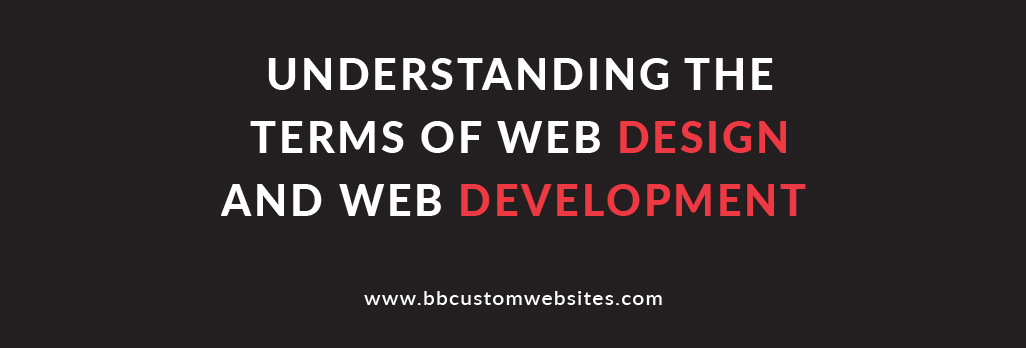Understanding the Terms of Web Design and Web Development

Web design, web development, UX/UI design, front-end/back-end development—these are all terms used in the tech world today to refer to websites. Do you feel confused by what these various terms mean and the difference between them?
If so, you’re not alone! Coming across this kind of terminology is intimidating and overwhelming for anyone who is not familiar with the industry. By knowing the definition for each term, however, you’ll be able to better understand what each one refers to and the difference between them, which is especially important if you are looking to have a website designed.
Here are some definitions for web design and development and the terms that fall under each category that we hope will serve to clear up any confusion that you have.
1. Web Design
“Web design” is a very broad term that covers pretty much everything that is related to designing the visuals and usability of a website. When most people think of web design, they usually think strictly in terms of how the website looks. However, web design covers so much more than that, such as functionality and the experience of the user. The term includes many different categories under one umbrella and so it is helpful to get into some of the specifics of what these are so that the term is less vague.
Web design relates to the visuals of a website. It is directly tied to graphic design and deals with the same design principles of visual communication. The web designer handles traditional graphic design concerns like color and typography along with digital concerns like choosing the best aesthetics for different screen sizes, adhering to the client’s brand guidelines, and designing graphics, icons, and illustrations for the site.
Web design also relates to functionality and how the website will work. When creating a design, a web designer must think about how the design will translate into a working website and what the user’s experience will be, keeping their behavior and expectations in mind. This is where the terms UI and UX design come into play, which both fall under the umbrella of web design.
User Interface Design (UI Design) is a specialization of web design that deals with the controls people use to interact with a website, including button displays, icons, and gesture controls. The goal of UI Design is not only to provide all the controls a user could want, but also to create self-explanatory and intuitive controls that users understand at a glance.
User Experience Design (UX Design) is another specialization of web design that deals with user behavior and feeling when using a website; it considers the design from the perspective of the user. The goal of UX Design is to create an atmosphere that provides a successful internal experience for the user and encourages certain behaviors and decision-making.
Additionally, web design relates to an understanding of Search Engine Organization (SEO) and business concepts like digital sales and marketing tactics. From incorporating certain keywords and highlighting specific content to strategically laying out pages and placing “Call-to-Action” buttons, web design implements specific strategies for accomplishing these ends and reaching the target audience.
These are just a few of the specific categories that fall under the term “web design.” As you can see, web design covers a broad area and web designers have many different responsibilities that they have to attend to while designing a website, in order to bring their client’s ideas to life. Typically, one of the last things a web designer will do is put together a mockup of the website design, which shows an exact representation of the website without functionality, and share it with a web developer so that he can then implement the design in code. This bring us to our next definition.
2. Web Development
Put most simply, “web development” is the technical part of making a website, focusing on code. It is when the website design is brought to life and converted into a working website with functionality and interactivity.
Website code can be defined as a system of symbols and rules used to represent instructions, a computer “language” that tells a website and its pages how to act. Code is what distinguishes web design from web development. Whereas a web designer deals with the graphics, visuals, and layouts of a website, a web developer deals with the code of a website that makes it work and is unseen by users.
Web development is further divided into two main categories, “front-end” and “back-end” development.
Front-end development deals with the code for how a website is displayed on screen. The front-end developer is in charge of bringing the website design to life, typically using computer languages like HTML, CSS and JavaScript.
Back-end development deals with the behind-the-scenes resources that are hosted on a server. The back-end developer manages these resources, coding the data in the database and optimizing how that data gets delivered with computer languages like PHP, Ruby, Python, Java or .Net.
Typically, web developers work back and forth with web designers, informing them of what is feasible with their design and receiving feedback from the designers about how to implement it. Thus it is important that good communication exists between a designer and developer on a project so that they can smoothly work in tandem together and successfully bring a website to execution.
We hope that these definitions of web design and development help you to understand more clearly what these terms refer to and what is involved with each one. Equipped with this knowledge, you’ll able to navigate the tech world more easily and not feel so intimidated by the technical lingo that is used during a website project.
For more information about these terms and to talk with a designer and developer who work hand in hand together to build custom websites, contact us today.
Back to Blog
